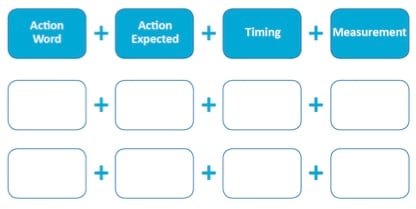
The employee performance review – do I hear crickets? If you’re like most managers, you dread the thought of sitting down and creating goals for your employees. Over the years I’ve written my fair share of reviews and every year I would cringe when I hit the send button; hoping, waiting, and anticipating that it wouldn’t get rejected. Then I learned about SMART goals, the answer to my dread.
Like any good performance review, the evaluation should revolve around the assessment of the employees’ skills and abilities. The goals should be outlined for the coming year and it may include training needs for the overall development of the employee. This is the ideal situation to define expectations and communicate how you will hold the employee accountable for those results.
SMART Goals are:
- Specific – what is the expectation; telling the employee they “need to do a better job” is not clear or specific. Tell them specifically what you want to see them do. Example: “By reading The ABC book and completing the online quiz, you will be better prepared to present to the team.”
- Measurable - it is easy to tell an employee what they need to do, but they want to know what the result will be and the reason for doing it. Provide them the results of attaining the goals; include the time, quality, cost, %, etc.
- Attainable – set realistic expectations and goals. Goals should not be a “gimme.” Allow the employee to stretch and be challenged; in the end the employee should be able to reach the goal and learn from getting there.
- Relevant – job-related goals associated to the employees’ role or tasks.
- Timely – set time frames to complete the goals. Creating goals is great, but if you are not providing a completion date, the focus and meaning can be lost.
As a manger, your goal is to establish clear expectations and you begin by defining the desired performance. While it may be easier to measure something as a defined sales goal, it is more of a challenge when the desired outcome is a behavior. It’s critical to take the time and think about the outcome and make sure the employee will be able to clearly understand your expectations and measurable guidelines.
How To Create A SMART Goal:
When you align the employee to the corporate goals and initiatives while building on their strengths and weakness you gain the best results.
Fill in the blank spaces with the right words to create SMART expectations or goals!

Performance behaviors and standards must be communicated to all employees and informing them that they will be held accountable is equally important. By not holding all employees to the same performance standards, you risk creating an imbalance in the workload. If employees are permitted to develop poor work habits or inadequate skills, their performance and your organization’s productivity will both be negatively affected. As the manager, your role is to evaluate employee’s achievements and effectiveness and make the necessary adjustments to encourage an increase in overall performance and productivity.

